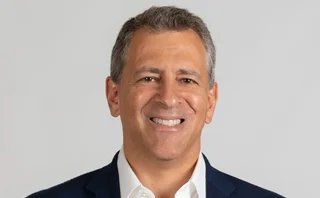
Weather house of the year: Endurance Global Weather
Team crafts innovative wind contracts to manage generators’ unique risks

Energy Risk Awards 2016
As wind power plays an ever-greater role in countries around the world, Endurance Global Weather (EGW) has been at the forefront of helping electricity firms handle their wind-related risk.
In Germany, for example, EGW created a first-of-its-kind structure for a ‘direct energy marketer', or direktvermarkter, a firm responsible for the dispatch and balancing of wind power into the German power grid. The firm earns income when wind blows its turbines, but it still has to pay expenses on windless days when those turbines sit idle and income is reduced.
"They have staff, a 24-hour desk and other systems, which means they have a large amount of fixed expenses they have to pay no matter what, but revenues which vary with the amount of wind that blows in a given year," says Martin Malinow, New York-based president of EGW.
Several years ago, EGW initiated a conversation with the direct marketer about its risk profile. "We said, ‘so if you have a really low wind year, then you could have revenues that fall short of your fixed expenses?' And they said, ‘yes.' And that was a problem," Malinow says.
Resolving that problem involved a technical challenge: for the deal to make sense, it had to be tailored to the map of the wind turbines managed by the client, and not Germany's entire wind fleet. EGW set about replicating the footprint of the firm's German assets – a task that was "really challenging", Malinow recalls.
"It needed a customised index," he says. "So we worked with the direct energy marketer, as well as a third party, to design an index that was representative of the entire footprint of assets they manage."
The solution was a unique contract, initiated in 2014 and renewed in an expanded version in 2015, that offered protection in the event of sluggish wind at the exact locations of the client's turbines.
Malinow says that's typical of EGW's approach: in-depth conversations to understand a client's needs, coupled with a willingness to experiment. It's an approach that has allowed EGW to make big leaps in the past 18 months, even though its five-person team is lean compared to those of the two largest firms in the weather risk space, Swiss Re and Munich Re.
"To be effective you need to be creative, and that requires turning a conversation into a proposed product, and then turning a proposed product into a final product," says Malinow, whose team is based in New York, London and Seattle. "Everybody on our team has that as their goal. It's written across our foreheads when we hit the pavement every morning."
EGW saw "significant growth" in transaction numbers and volumes last year, Malinow says, though he declined to give exact figures. A unit of Bermuda-based reinsurer Endurance, EGW also built on its traditional base of clients in the energy industry to close deals in the agriculture, transportation and construction sectors.
Another innovative deal the firm executed in 2015 – one not unheard of in weather markets, but which marked a new development for EGW – was insuring an integrated energy company in Europe against a combination of extreme cold and low wind at specific wind-farm locations.
For this client, a warm winter typically meant lower revenues, because fewer clients crank up their thermostats in mild weather. Protection against lower revenues resulting from warm weather was the main type of protection this type of client purchases in the winter, Malinow says.
But to balance its own portfolio, EGW sought to offer protection against cold weather too – and said precisely that in its dialogues with the client.
"It was a very frank conversation," Malinow says. "We said, ‘this kind of risk could fit our portfolio, and we could sell it at an attractive, aggressive price that should work for you.'"
The client's first reaction was "we love cold weather because we sell more energy", according to Malinow. But EGW followed up: was all cold weather really equal? Could there be a type of cold weather for which the client needed protection?
The client considered. Then the company noted it derived a significant amount of its electricity supplies from wind turbines. A cold snap on a day with low wind would force the firm to buy additional fuel in the spot market – on a day when demand, and prices, were likely to be above average. The result of the discussion was a dual-trigger contract, tailored to the client's wind-generating assets, that provided protection against the combination of extreme cold and low wind.
"We were able to come up with an arrangement that worked for both parties," Malinow says. "Just goes to show, it never hurts to ask."
Only users who have a paid subscription or are part of a corporate subscription are able to print or copy content.
To access these options, along with all other subscription benefits, please contact info@risk.net or view our subscription options here: http://subscriptions.risk.net/subscribe
You are currently unable to print this content. Please contact info@risk.net to find out more.
You are currently unable to copy this content. Please contact info@risk.net to find out more.
Copyright Infopro Digital Limited. All rights reserved.
As outlined in our terms and conditions, https://www.infopro-digital.com/terms-and-conditions/subscriptions/ (point 2.4), printing is limited to a single copy.
If you would like to purchase additional rights please email info@risk.net
Copyright Infopro Digital Limited. All rights reserved.
You may share this content using our article tools. As outlined in our terms and conditions, https://www.infopro-digital.com/terms-and-conditions/subscriptions/ (clause 2.4), an Authorised User may only make one copy of the materials for their own personal use. You must also comply with the restrictions in clause 2.5.
If you would like to purchase additional rights please email info@risk.net
More on Commodities
Energy Risk Asia Awards 2025: The winners
Winning firms showcase the value of prudent risk management amid challenging market conditions
Data and analytics firm of the year: LSEG Data & Analytics
Energy Risk Awards 2025: Firm’s vast datasets and unique analytics deliver actionable insights into energy transition trends
OTC trading platform of the year: AEGIS Markets
Energy Risk Awards 2025: Hedging platform enhances offering to support traders and dealers in unpredictable times
Electricity house of the year: Natixis CIB
Energy Risk Awards 2025: Bank launches raft of innovative deals across entire electricity supply chain
Voluntary carbon markets house of the year: SCB Environmental Markets
Energy Risk Awards 2025: Environmental specialist amplifies its commitment to the VCM
Sustainable fuels house of the year: Anew Climate
Energy Risk awards 2025: Environmental firm guides clients through regulatory flux
Weather house of the year: Parameter Climate
Energy Risk Awards 2025: Advisory firm takes unique approach to scale weather derivatives markets
Hedging advisory firm of the year: AEGIS Hedging
Energy Risk Awards 2025: Advisory firm’s advanced tech offers clients enhanced clarity in volatile times







